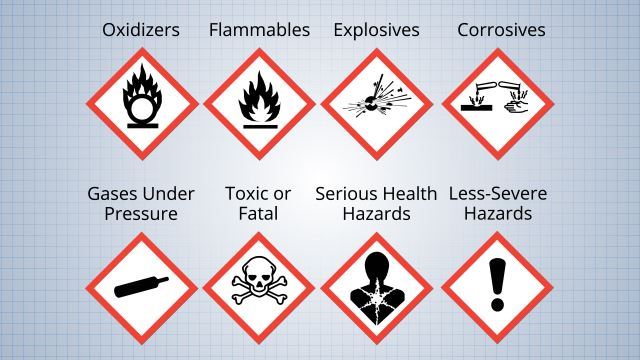8 Diseases Caused by Exposure to Hazardous Material at The Workplace
Although many organizations have followed the ban against using hazardous materials in the workplace, including asbestos, it’s still a major cause of concern in certain regions. Harmful substances are abundantly found in toxic environments, particularly offices and factories that deal with chemicals daily. If you don’t wear the proper gear while working in such places, there’s a high risk of developing certain short and long-term diseases. At times, they could even be fatal.
In the UK alone, around 5000 people die every year from the harmful consequences of asbestos exposure. Likewise, in the US, a 2018 study found that more than 39,000 people had succumbed to toxicity in the environment.
Let’s go through some common diseases caused by exposure to hazardous materials at the workplace:
-
Lung cancer
Mesothelioma – arising from asbestos exposure – is one of the most common cancers caused by exposure to toxic compounds at the workplace. When you inhale lots of asbestos fibers over the years, they accumulate in the lining of your lungs or abdomen and form a malignant tumor. Depending on the tumor’s location, you might be diagnosed with pleural or peritoneal mesothelioma. Eventually, they lead to serious symptoms like chest pain, shortness of breath, and coughing.
Of course, treating this kind of cancer can be highly expensive. Nonetheless, by filing a mesothelioma cancer lawsuit, you can get financial compensation from your company for the medical expenses.
-
Prostate cancer
Long-term exposure to harmful substances in the workplace can make men prone to prostate cancer as well. It’s a male genital cancer that attacks the prostate. This disease causes the prostate gland to grow, affecting the ability to urinate properly and having problems with fertility. As a result, you might want to pee too much, and it could disturb your sleep. You might also notice blood in the pee.
Prostate cancer is also responsible for the heaviness of aches in the lower body region. If you notice these alarming signs, you might have prostate cancer caused by workplace toxicity.
-
Breast cancer
According to a study, women over 40 and postmenopausal women were 1.3 times more likely to have breast cancer when they worked in offices with chemicals. Breast cancer is yet another painful type of cancer that mostly targets females. It leads to the development of tumors or lumps in the breasts. These tumors may be benign or malignant. If you have breast cancer, you might notice rashes, abnormal nipple discharge, and pain in the chest and neck.
You might feel lumps as well in the breasts or underarms. Early detection of breast cancer and on-time treatment can increase the patient’s life. The later it is detected, the more are the chances of fatality.
-
Heart conditions
Both men and women exposed to toxic materials in the workplace are at an increased risk of developing cardiovascular diseases. A study found that asbestos absorption in men is 63% more likely to cause stroke and 40% likely to cause heart diseases. Moreover, almost every female is at high risk of developing a heart condition from asbestos exposure.
Heart disease often creeps up slowly and hits when you least expect it. It may start as a stabbing pain in the chest, neck, or jaw or a dull ache in the left arm. Before a heart attack, you might have digestive problems as well.
-
Congenital disabilities
Pregnant women in workplaces who are exposed to harmful substances for a long time can be at high risk of pregnancy complications resulting in congenital disabilities. Congenital disabilities are among the leading cause of infant death and can cause serious problems in the baby’s life. Suppose either of the parents isn’t careful. In that case, chemical inhalation or absorption can cause nutritional deficiency, genetic mutations or reach the fetus through the blood or placenta. As a result, the baby might be born with mental or physical developmental issues.
So, if you have a kid with congenital disabilities, it may be because of hazardous exposure.
-
Anxiety
This information may be hard to wrap your head around, but being around harsh chemicals for years can mess up your mental health. Several credible studies have shown that people who work with loads of hazardous materials are increasingly prone to depression, anxiety, stress, anger, apathy and may not be able to perform well socially. These are undeniably some of the most common symptoms of workplace toxicity. You might also feel too full and unable to eat because of a lack of appetite.
-
Parkinson’s disease
Hazardous material poisoning is also responsible for causing serious neurological diseases in the long run. Those who closely work with insecticides like permethrin are at increased risk of developing tremors, medically known as Parkinson’s disease. It can disturb the quality of life and interfere with normal performance.
The symptoms include shaky grip, dizziness, or headaches. You might also have problems with balance and hand-eye coordination. So, if you notice any of the above signs, you might have toxic material exposure. Parkinson’s disease progresses as you age, and it’s impossible to treat. However, various medications are available to control the symptoms.
-
Asthma
Numerous harmful chemicals in the workplace can trigger infections in your respiratory system. If you repeatedly inhale asbestos for a long time, you might also develop asthma symptoms. It is a breathing disease that messes up the lungs. People feel a burning sensation of inflammation while breathing, cough a lot, and have shortness of breath. Asthma may be acute or chronic – meaning it might disappear on its own or stay with you for life.
Final Thoughts
Besides the conditions mentioned above, you are prone to various other health issues, including kidney and liver damage and severe redness or rashes on the skin. Harsh chemicals can also harm your vision and lead to red eyes. Ideally, it’s important to work in environments where you don’t have to inhale the fumes often. Keeping such spaces well-ventilated can be a huge benefit to such workers. Organizations should conduct thorough inspections every few months to monitor the amount of toxicity at the workplace and see how deadly it could be. It’s also necessary to introduce strict laws against workplaces that are lenient in this regard by enforcing hefty fines to those who don’t comply.



